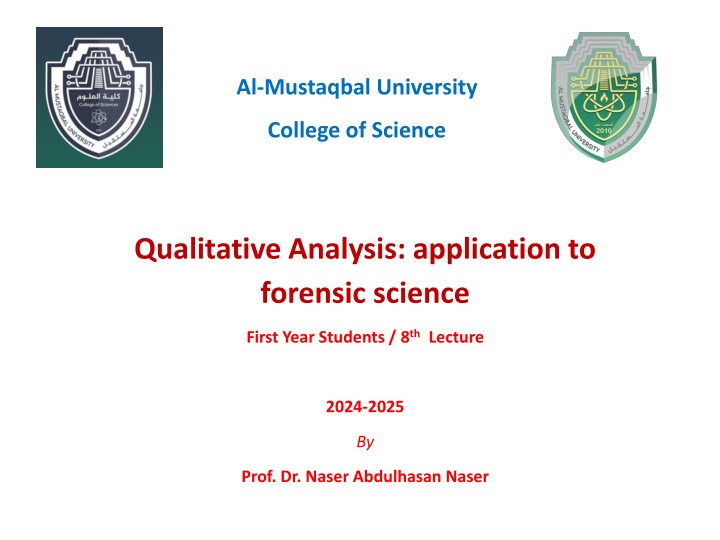
Forensic Science Applications: Qualitative Analysis Methods in Detection
Discover the use of Marquis Reagent, Chen-Kao Reagent, Cobalt Thiocyanate Test, and Mayers Reagent in forensic science for identifying various compounds such as alkaloids and illegal drugs. Learn about their preparation, reactions, and significance in identifying substances through color changes.
Download Presentation

Please find below an Image/Link to download the presentation.
The content on the website is provided AS IS for your information and personal use only. It may not be sold, licensed, or shared on other websites without obtaining consent from the author. If you encounter any issues during the download, it is possible that the publisher has removed the file from their server.
You are allowed to download the files provided on this website for personal or commercial use, subject to the condition that they are used lawfully. All files are the property of their respective owners.
The content on the website is provided AS IS for your information and personal use only. It may not be sold, licensed, or shared on other websites without obtaining consent from the author.
E N D
Presentation Transcript
Al-Mustaqbal University College of Science Qualitative Analysis: application to forensic science First Year Students / 8th Lecture 2024-2025 By Prof. Dr. Naser Abdulhasan Naser
Marquis reagent is used as a simple spot-test to presumptively identify alkaloids as well as other compounds. It is composed of a mixture of formaldehyde and concentrated sulfuric acid, which is dripped onto the substance being tested. The United States Department of Justice method for producing the reagent is the addition of 100 mL of concentrated (95 98%) sulfuric acid to 5 mL of 40% formaldehyde. Different compounds produce different color reactions. Methanol may be added to slow down the reaction process to allow better observation of the colour change. Used for detection MDMA and MDA with dark violet color 2C-B of yellow to green color
Chen- Kao Reagent Test Preparation of Reagent: Reagent 1: This is prepared by adding 1 ml of Glacial Acetic Acid in 100 ml of Water, i.e., 1% (V/V) aqueous Acetic Acid solution. Reagent 2: This is prepared by dissolving 1 gm of Copper (II) Sulphate in 100 ml of Water, i.e., 1% (W/V) aqueous CuSO4 solution. Reagent 3: This is prepared by dissolving 8 gm of Sodium Hydroxide in 100 ml of Water, i.e., 2N aqueous Sodium Hydroxide solution. A violet color indicates presence of ephedrine or pseudoephedrine
Cobalt Thiocyanate Test(Scotts Test) This test is a presumptive field test for illegal drugs. The test reagent is a 2% aqueous solution of Cobalt (II) Thiocyanate which is mixed with a small amount of sample. Scott test is a simple, rapid, and low-cost preliminary test used extensively to suggest the presence of cocaine in drug seizures due to the development of a blue color. Cobalt(II) thiocyanate is an inorganic compound with the formula Co(SCN)2.The anhydrous compound is a coordination polymer with a layered structure. The trihydrate, Co(SCN)2(H2O)3, is a isothiocyanate complex, used in the cobalt thiocyanate test (or Scott test) for detecting cocaine.
Mayers Reagent Test Preparation of Reagent: Potassium Mercury Iodide prepared by dissolving 1.357 gm. of Mercuric Chloride HgCl2 and 5 gms of Potassium Iodide KI in 100 mL of water. This test is performed for the detection of Nicotine. The dried residue of extract is acidified with Acetic Acid followed by addition of 2 drops of reagent. A white or yellowish precipitate is obtained.















